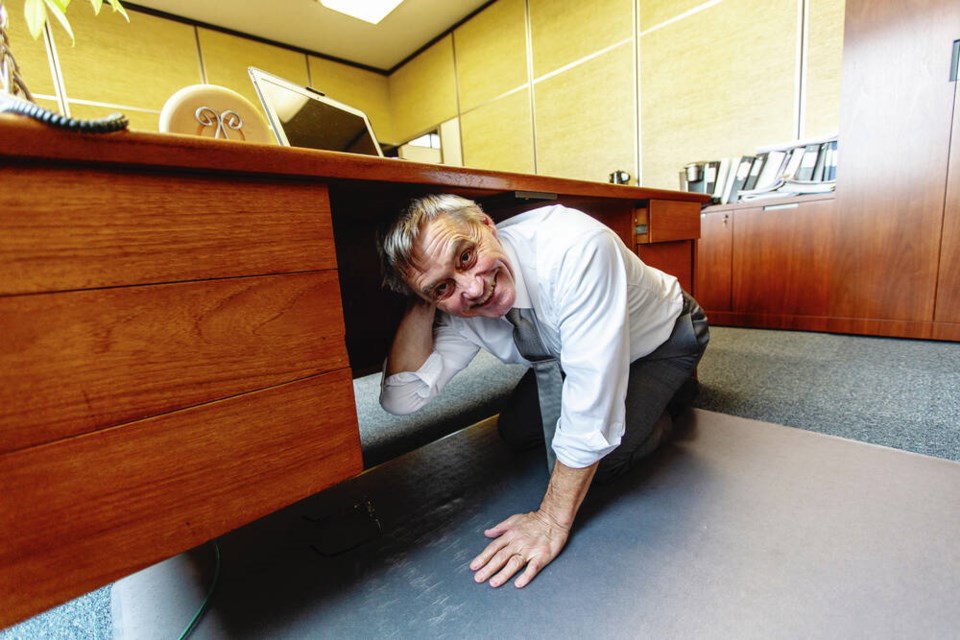The Great B.C. ShakeOut, the world’s largest earthquake drill, returns Thursday, with participants asked to drop, seek cover and hold onto a desk or table at 10:21 a.m.
In 2019, more than a million individuals, businesses, various levels of governments and schools registered for the annual drill, which turns 10 this year.
Globally, almost 24 million have already registered to take part in ShakeOut drills.
According to seismic experts, there is a 32 per cent probability of a major earthquake in the region in the next 50 years. More than 1,200 minor ones are recorded annually. While an earthquake can take place anywhere in Canada, B.C. is considered at high risk compared with the rest of the country.
“The key goal is to practice the drill so that people can quickly protect themselves in case of an earthquake,” said Dr. John Cassidy, earthquake seismologist with Natural Resources Canada. “It is a reminder to us that simple things can make a difference.”
He said that while “drop and cover” has been recommended for a number of years, the “hold on” action was added in recent years.
“In an earthquake, the furniture you take refuge under can move around a lot,” said Cassidy, who is stationed in Sidney. “In the case of a very large earthquake, the tremors can last up to five minutes.”
Most people would be aware of an imminent earthquake through the p-wave (primary or pressure wave), or sound. P waves travel faster than other seismic waves and are the harbinger of what is to come.
As the ground moves, it feels like an up and down motion. If the ground is moving side to side, it indicates a shear earthquake, which causes more extensive damage to structures.
Earthquakes that take place out at sea or several kilometres under the surface cause little damage, but those closer to the surface and near urban centres can inflict significant damage on structures and infrastructure, as in Christchurch, New Zealand in 2010.
Cassidy said B.C. has had earthquake codes in buildings since 1952, and they have been improving constantly. .
He said wood-frame single houses — the dominant construction type in the region — fares the best in an earthquake because the wood can move with the ground. “There will be a lot of broken windows, but at least the house will still be standing.”
Critical infrastructure, such as dams and bridges, is designed to withstand tremors, guided by research into past earthquakes.
Cassidy said that small earthquakes happen almost every day, with large ones about a decade apart.
The strongest recorded on Vancouver Island took place in 1946, a magnitude 7.3 event. It still holds the record as Canada’s largest onshore earthquake. The epicentre was in the Forbidden Plateau area northwest of Courtenay.
Since then, the majority of the larger tectonic earthquakes in the region have occurred offshore and have caused little damage.
Even if the initial earthquake is far from land, it can still be dangerous and destructive if it creates a tsunami that threatens coastal communities.
The most destructive tsunami recorded in the Pacific Ocean was also in 1946, after an earthquake in Alaska.
Before written records were kept, the Indigenous peoples of the region, through their oral history, reported a very large earthquake — estimated to be over 9 in magnitude — that took place sometime in the 1700s.
The story keepers tell of an event that knocked people over and a tsunami that devastated coastal villages.
Tsunami researchers were able to confirm the event through tree rings and from wave heights from Japanese records from the same era.
Scientists are able to determine the severity of historical earthquakes by looking at written reports of observations by witnesses — for example, items falling from shelves — and determining what magnitude it would take to create the action, Cassidy said.
“They use that data to link historical events that may have taken place hundreds of years ago and link them with modern events to improve our understanding of earthquakes.”
CFB Esquimalt will participate in the drill by sounding a siren starting at 10:21 a.m. The siren sounds much like that of an emergency vehicle and will last approximately one minute. A short voice message will accompany it.
Central Saanich, North Saanich and Sidney residents who have signed up for the region’s alert system will get a test email, phone or text at 10 a.m. Thursday as a reminder to participate in the ShakeOut.
Some radio stations on Vancouver Island are planning to broadcast the drill live.
To register, go to shakeoutbc.ca.
parrais@timescolonist.com



